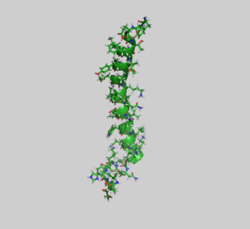Gastric inhibitory polypeptide (GIP), also known as glucose-dependent insulinotropic polypeptide, is an inhibiting hormone of the secretin family of hormones.[5] While it is a weak inhibitor of gastric acid secretion, its main role, being an incretin, is to stimulate insulin secretion.[6]
GIP, along with glucagon-like peptide-1 (GLP-1), belongs to a class of molecules referred to as incretins,[7] which stimulate insulin release on oral food intake.
- ^ a b c GRCh38: Ensembl release 89: ENSG00000159224 – Ensembl, May 2017
- ^ a b c GRCm38: Ensembl release 89: ENSMUSG00000014351 – Ensembl, May 2017
- ^ "Human PubMed Reference:". National Center for Biotechnology Information, U.S. National Library of Medicine.
- ^ "Mouse PubMed Reference:". National Center for Biotechnology Information, U.S. National Library of Medicine.
- ^ Meier JJ, Nauck MA (2005). "Glucagon-like peptide 1(GLP-1) in biology and pathology". Diabetes/Metabolism Research and Reviews. 21 (2): 91–117. doi:10.1002/dmrr.538. PMID 15759282. S2CID 39547553.
- ^ Pederson RA, McIntosh CH (2016). "Discovery of gastric inhibitory polypeptide and its subsequent fate: Personal reflections". Journal of Diabetes Investigation. 7 (Suppl 1): 4–7. doi:10.1111/jdi.12480. PMC 4854497. PMID 27186348.
- ^ Efendic S, Portwood N (2004). "Overview of incretin hormones". Hormone and Metabolic Research. 36 (11–12): 742–6. doi:10.1055/s-2004-826157. PMID 15655702. S2CID 11634548.




